 |
 |
 |
| |
Increasing Neuroinflammation in People With HIV Tied to Worse Neurodegeneration
|
| |
| |
International Workshop on HIV and Aging, October 13-14, 2022
This is 1 of 2 presentations focused on cognitive function of great interest. This study find neuroinflammatipn ted to neurodegeneration but is that the same as cognitive impairment? I think its a surrogate for cognitive impairment & provides some evidence that for some - those with neuroinflamation - cognitive impairment decline progression may decline with age. The 2nd presentations provides mixed evidence that PLWH may be at greater risk for alzheimers or a similar syndrome - but there are a bunch of studies finding mixed results and as I think Beau Ances commented the studies may be confounded because of being in different populations of patients. This report coming next. Jules
By Mark Mascolini for NATAP and Virology Education
A 12-year study linked rising markers of (1) neuroinflammation and immune activation and (2) systemic inflammation and immune activation to increased neurodegeneration in a US group of people taking suppressive antiretroviral therapy (ART) [1]. Researchers working with the CHARTER Aging project believe their findings "raise the possibility that reducing neuroinflammation and systemic inflammation will slow or reverse neurodegeneration, a possibility that can be evaluated in clinical trials."
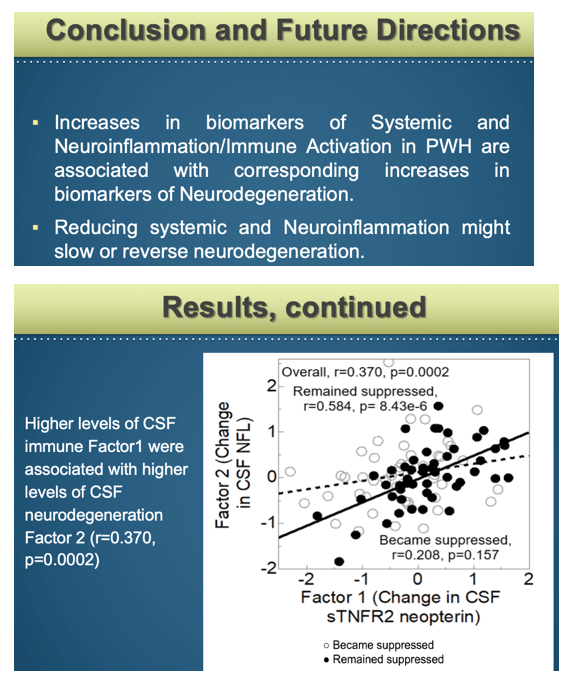
The CHARTER team noted that cell studies show HIV infection causes both neuroinflammation and immune activation and systemic inflammation and immune activation. A more convincing demonstration that rising inflammation/activation marker levels drive neurodegeneration could come from longitudinal study of people with HIV.
Researchers measured 14 markers of neuroinflammation and immune activation, systemic inflammation and immune activation, and neurodegeneration in blood plasma and cerebrospinal fluid (CSF) at an initial visit and 12 years later in the US multisite CHARTER study. The 14 biomarkers were CRP, sCD40L, and d-dimer in plasma; NFL, total Tau, sAPP-α, Aβ42, and phosphorylated tau in CSF; and IL-6, sTNFR-II, 8-oxo-DG, neopterin, MCP-1, and sCD14 in both plasma and CSF.
The investigators eliminated CHARTER members who had severe medical or neuropsychiatric conditions that could skew findings. The analysis included only people with a plasma viral load below 50 copies at the 12-year follow-up visit. After figuring the change in marker levels from the initial visit to the 12-year visit, the researchers used factor analysis to define simple indicators of neuroinflammation and immune activation, systemic inflammation and immune activation, and neurodegeneration. Then they looked for correlations between those factors.
The analysis included 53 people who became virally suppressed during follow-up and 55 who were initially suppressed and remained suppressed. People who remained suppressed included a significantly higher proportion of women (22% vs 6%) and tended to differ in racial makeup: black 58.5% of the remained-suppressed group and 41.5% of the became-suppressed group, non-Hispanic white 42% vs 58%, Hispanics 50% and 50% (P = 0.0874 overall). The remained-suppressed group and the became-suppressed group were similar in average age (58 and 55) and current median CD4 count (both 579).
Factor analysis to define simplified signals of neuroinflammation and immune activation, systemic inflammation and immune activation, and neurodegeneration yielded the following factors:
Plasma immune factor analysis:
Factor 1: CRP, d-dimer, neopterin
Factor 2: sTNFR-II
Neurodegeneration factor analysis (CSF):
Factor 1: pTau, Aβ42
Factor 2: NFL
CSF immune factor analysis:
Factor 1: sTNFR-II, neopterin
Factor 2: MCP-1, sCD14, IL-6
Higher levels of CSF immune Factor 1 (change in CSF sTNFR-II, neopterin) were associated with worse CSF neurodegeneration (r = 0.370, P = 0.0002). This association was much stronger in people who remained suppressed throughout follow-up (r = 0.584, P = 8.43e-6) than in people who became suppressed during follow-up (r = 0.208, P = 0.157). CSF immune factor 2 did not correlate with CSF neurodegeneration.
Further analysis showed an association between older age and several markers of neurodegeneration at baseline, especially CSF sTNFR-II (r = 0.438, P = 2.60e-6) and CSF NFL (r = 0.374, P = 8.03e-5). But older age was not associated with changes in these same biomarkers over time.

The researchers concluded that in people with HIV markers of neuroinflammation and immune activation and systemic inflammation and immune activation are associated with increasing levels of neurodegeneration biomarkers. They proposed that quelling systemic and neuroinflammation in people with HIV may slow or reverse neurodegeneration.
Reference
1. Tavasoli A, Gelman B, Marra C, et al. Increasing neuroinflammation relates to increasing neurodegeneration in PWH. International Workshop on HIV and Aging, October 13-14, 2022. Abstract 4.
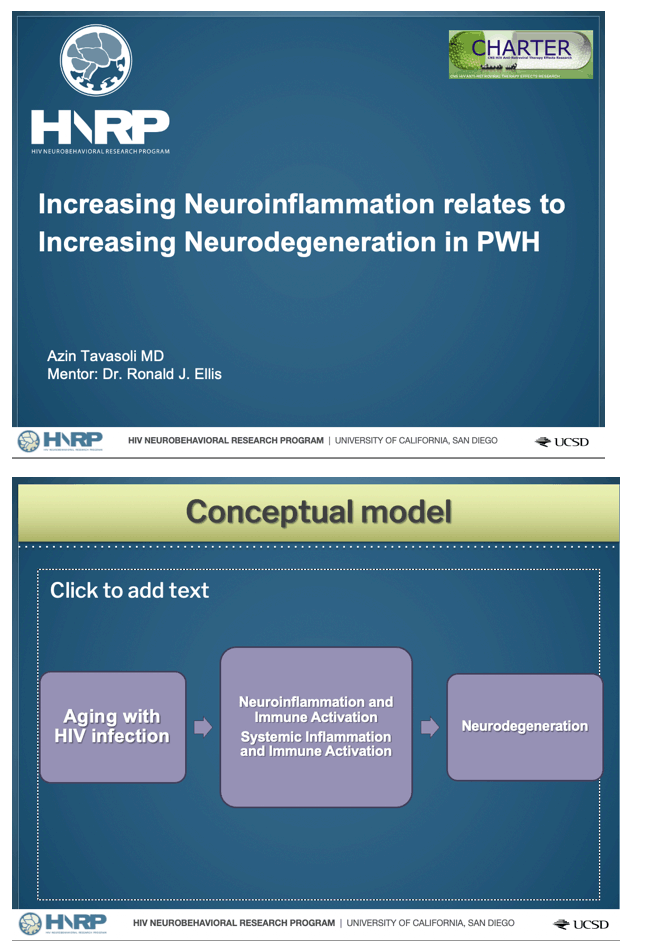

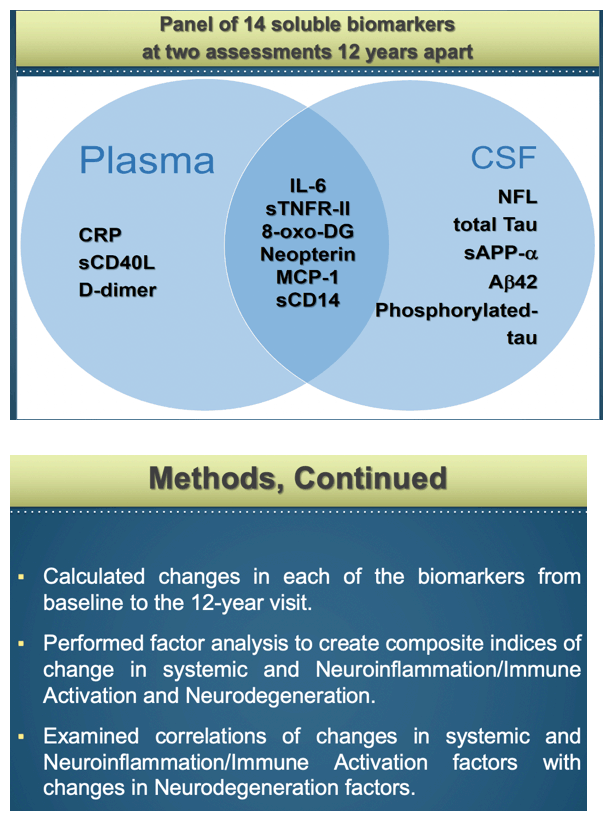
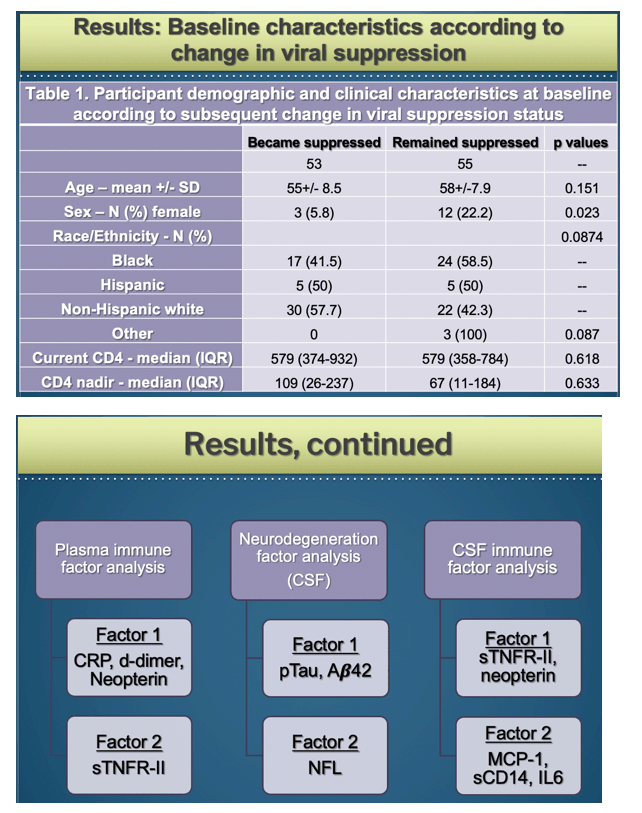

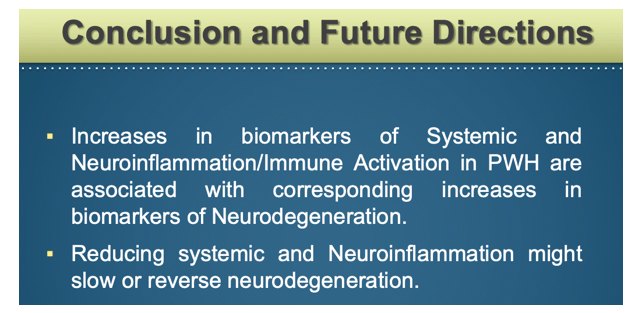
|
| |
|
 |
 |
|
|